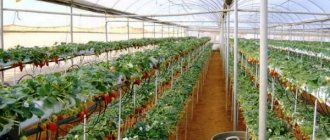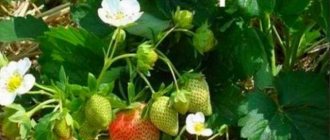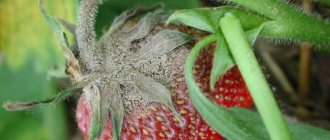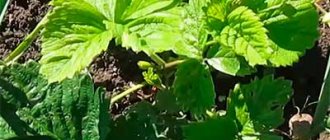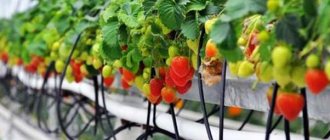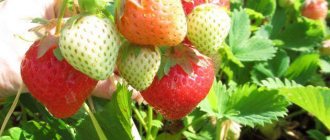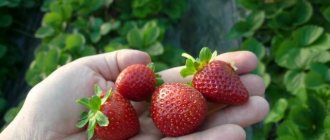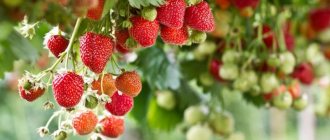The Dutch have proposed an interesting method for growing strawberry bushes to harvest year-round berries. Every year it is gaining momentum due to its effectiveness and relative simplicity. Anyone can try out the Dutch method of growing strawberries in action, even on an apartment windowsill.
Features of the Dutch technique
The basis of the method is year-round continuous harvesting of strawberries. The first wave of harvest is followed by the next and this cycle is not interrupted. This distinguishes this direction from the traditional way of growing strawberries.
The Dutch method has its own characteristics:
- The room must be equipped, and the soil in which the strawberry bushes are planted must be closed. Choose containers for planting that match the planting method. These can be boxes, pots, bags, buckets, etc.
- The plant does not have the ability to produce crops all year round, so after harvesting it is replaced with prepared seedlings. Bushes are replaced on average every 7-9 weeks.
- In this technology, watering and fertilizing are used only by drip.
- You can place strawberry bushes in beds vertically or horizontally.
Creating a beneficial temperature regime
Temperature and ventilation
How to grow strawberries in a greenhouse? To do this, it is necessary to create an optimal temperature regime inside the structure.
Advice. According to Dutch technology, the temperature in the greenhouse should not be higher than room temperature.
Features of temperature conditions:
- All this is due to the fact that the berry bushes are not located on the ground itself, but above its surface. The temperature will always be higher at the top, since warm air is light and rises very quickly.
- To heat a greenhouse, an automatic electric heating system is most often used. It has a special sensor that turns on the system when a certain temperature is reached on the thermometer.
Such innovations help save time and money, since the system also turns off automatically when the set temperature is reached.
Ventilation of the greenhouse structure
Growing strawberries in greenhouses is also characterized by high-quality ventilation. Thanks to this, fresh air enters the structure and heated air masses exit. The greenhouse ventilation system can be:
- Manual, which is based on the independent opening of the windows.
- Automatic, which uses special electrical and hydraulic equipment with a variety of sensors. Provides automatic opening and closing of the window when a certain temperature condition is reached inside the greenhouse.
Advice. To properly connect such equipment and ensure a long service life, there are special instructions according to which the entire installation process is carried out.
Greenhouse lighting
Correct lighting
Additional lighting of the greenhouse is necessary if the structure is used all year round. All this is due to the fact that in winter and autumn there is much less daylight than in spring or summer, and to get a normal strawberry harvest you will need at least 10-14 hours of daylight.
Advice. To illuminate a greenhouse, it is best to use fluorescent lamps rather than conventional lighting fixtures.
Watering strawberry bushes
How to grow strawberries in a greenhouse? We can say that it is impossible to do without high-quality lighting and watering. In order to ensure uniform irrigation of each berry bush, it is worth using an automatic system. What it is:
- The system is equipment that operates from a supply of electrical energy and is capable of automatically turning off and on thanks to numerous sensors.
- The video shows this process.
- In this case, the sensors are set to certain modes to turn on irrigation and to turn it off.
Advantages and disadvantages of the technique
Every year, the strawberry growing method proposed by the Dutch becomes more and more popular due to its obvious advantages:
- in a small area you can place an impressive number of seedlings;
- arrangement of seedlings in any suitable container;
- sufficient natural light for all strawberry bushes when grown in heated structures made of material that transmits sunlight;
- for the method it is possible to equip any shelter;
- since the berries do not have contact with the ground, they are maximally safe from the transmission of diseases and pest attacks;
- short growing season - berry picking is possible within 1.5-2 months from planting;
- fresh berries all year round;
- using an established growing mechanism over a long period of time;
- The taste of strawberries is identical to those grown in open ground.
Disadvantages of the Dutch method:
- The need for a constant presence of young mustaches. Planting material is used year-round, so it should always be available. When small volumes of strawberries are grown, it is profitable to grow seedlings yourself; on large farms with a large scale of production, it is much more profitable to purchase them.
- Continuous maintenance of the microclimate and control of lighting in the greenhouse.
How are strawberries grown in Holland?
For year-round cultivation on an industrial scale, greenhouses are, of course, used. They maintain a microclimate favorable for strawberries. From autumn to spring, daylight hours are artificially lengthened. A drip irrigation system is installed, and nutrient solutions are supplied through it. High-yielding and early-ripening varieties with marketable berries are selected. However, this is not enough.
The main principle of Dutch technology is strawberries all year round
The biological peculiarity of this crop is such that it bears fruit once per season, remontant varieties - 2-3 times. After fruiting, flower buds of the new crop are laid and a dormant period begins. Dutch farmers who make money from selling strawberries cannot wait for the next harvest. They need a continuous flow of money, which means berries. Therefore, every 1.5–3 months, new planting material is planted, so that the plants begin to produce their harvest by the time the last fruits have already been harvested from the previous ones. Bushes that bear fruit are mercilessly removed.
The cost of out-of-season strawberries, especially during the holidays, increases 8–10 times. Although in summer this berry is not cheap.
Video: greenhouse for year-round cultivation of strawberries
Suitable varieties for growing
To produce strawberries using the Dutch farmers’ method, you need to choose the right varieties. Remontant ones are especially suitable. Their advantage is the ability to self-pollinate. If insects are used to pollinate flower stalks, beehives are placed in large rooms. Artificial wind created by fans is suitable for this purpose.
The following varieties are preferred:
- Darselect. An early ripening variety from France with orange-red-brown heart-shaped berries. Has average winter hardiness. From each bush you can harvest up to 1 kg of crop.
- Marmalade. Two waves of comb-shaped, bright red berries native to Italy. Productivity up to 900 g of berries per bush.
- Polka. The conical berries are deep red in color. Up to 1 kg of large berries is harvested from each strawberry bush.
- Selva. Super-yielding variety from America. The weight of fruits per bush is about 1.5 kg.
- Sonata. Variety from Holland. The berries are large, bright, mid-ripening. Withstands light frosts. The yield is up to 1.5 kg of berries per bush.
- Tristar. Strawberries crossed with Milanese strawberries produce high yields of large red berries. Frost-resistant.
variety “Darselect”
“Marmalade” variety
“Polka” variety
variety “Selva”
variety “Sonata”
variety “Tristar”
In addition to these, it is possible to plant varieties Tribute, Gloom, Baron, etc.
Diseases and control methods
The crop is susceptible to a number of ailments and pests, a detailed description of which is presented below.
Brown spot
This is a disease of fungal etymology, the symptoms of which appear during fruiting. Brown spots of various sizes appear on the surface of the foliage, without clear boundaries. Over time, the affected areas grow, merging together. The infected green mass dies, leading to the death of the entire plant.
The main causes of the disease include:
- dense plantings;
- excessive watering and dampness;
- low temperatures.
For treatment, use a 1% solution of Bordeaux mixture or copper oxychloride. They spray the entire surface of the bush.
Verticillium wilt
A fungal disease that develops in the soil. The spores infect the vessels that carry water, and the mycelium, in turn, releases toxins that have a detrimental effect on the strawberries. The lower foliage dries out and the berries turn brown. Over time, the entire bush dries out.
To treat affected plants, use a 3% Bordeaux mixture, which is prepared from:
- 10 liters of water;
- 300 g of copper sulfate;
- 450 g quicklime.
Strawberries are completely sprayed with the preparation.
Nematodes
This is a parasite in the form of a miniature worm that damages the tissues of the roots and stems of the crop by sucking its juices and releasing toxins. Male nematodes look like a thin yellow thread 2 cm long, while females are shorter and thicker.
The main symptoms of damage include:
- slow growth;
- deformation of the ovary;
- rolled leaves.
To combat the pest, an infusion of marigolds is used. To prepare it, you need to soak 1 kg of flowers for 2 days in 10 liters of water. After using it, you can water the strawberry bushes.
Weevil
A gray-black beetle with a long elongated proboscis. The insect feeds on strawberry foliage. To combat this type of pest, use an iodine solution at the rate of 1 tsp. on a bucket of water. The prepared preparation is used to irrigate the land.
Thanks to the technology described above from Holland, it is possible to grow strawberries in closed ground conditions all year round. The method is quite simple and accessible to everyone. Follow all the recommendations indicated above and grow your favorite berries even on your balcony.
Sources:
https://diz-cafe.com/sad-ogorod/vyirashhivanie-klubniki-po-gollandskoy-tehnologii.html https://tytdacha.ru/sad-i-ogorod/yagodnye-kustarniki/vyrashhivanie-klubniki-po-gollandskoj -tehnologii/ https://fermer.blog/bok/sad/yagody/klubnika/klubnika-vyraschivanie-i-uhod/sposoby-vyraschivaniya-klubniki/8400-klubnika-po-gollandskoj-tehnologii.html
Planting methods
According to the method of growing strawberries proposed by the Dutch, both the horizontal method of placing bushes during planting and the vertical arrangement are equally good. The alternative is determined by the area of the room and its equipment with an additional lighting system.
Horizontal
With this method of arranging seedlings, they are planted in a single line, placing containers in rows parallel to the floor surface. This planting method is applicable for large volumes and areas. Considered less expensive. Can be used in conjunction with the vertical method of placing strawberry bushes.
Watch a video about the horizontal method of planting strawberry seedlings:
Vertical
Vertical landing is located at right angles to the floor. Cascading planting, in compliance with a checkerboard pattern, allows plants not to come into contact with each other as they grow. Therefore, maintain a gap of at least 25 cm between strawberry bushes. Use PVC pipes, bags, boxes and other containers. The method has found application in small farms and among gardeners.
The vertical method of planting strawberries is presented in the video below:
Selection and preparation of strawberry seedlings
Despite the time of year, many agricultural companies sell strawberry seedlings. They often offer a special variety called Frigo. The price for it is always at a fairly high level. But, what is very important, any gardener can produce such seedlings from his own plot. After all, this variety is just like well-grown strawberry bushes. They are dug up in the fall and cooled well. During the winter, strawberry cuttings are stored at low temperatures:
- in refrigerators and freezers;
- in fairly cool basements and cellars.
When the time for planting a new batch of seedlings approaches, they are taken out of storage and planted. There is no need to be afraid that the cuttings will freeze. After all, the same thing happens in nature. Strawberries in open ground also undergo a process of natural preservation when they are covered with snow in winter.
The main task for the farmer is to create a certain artificial environment so that the seedlings go into “deep hibernation.” And if necessary, she was ready to disembark again. These are the main technological processes for growing strawberries using the Dutch method.
When choosing strawberries for seedlings, you should pay attention to self-pollinating species. Naturally, it is best to choose Dutch varieties with high yields:
When planting these varieties of strawberries at your dacha, you will need to cut off all the flowers and tendrils from the mother tubers during the first year. This will help prepare good, strong seedlings for next year. To do this, you need to dig in the tendrils that appear and let them take root.
Starting from the second half of October, when the temperature usually drops to -3 degrees, strawberries will be in “hibernation”. At this moment it is necessary to dig up young cuttings. All large leaves and remnants of shoots must be removed from the bushes. To prevent the death of seedlings, under no circumstances should you manipulate the root of the plant (wash, trim). After this, the strawberries are left in a cold room to continue their “sleep”.
Preparing conditions for growing strawberries
The first thing that is necessary for the good development of strawberries according to the Dutch method is correctly selected and prepared soil. Its yield also depends on the soil in which the berry grows. To prevent the development of diseases and the appearance of pests, you should never take sandy soil with rotted manure.
The best option would be a special substrate mixture based on chernozem and the addition of mineral elements. Such soil will be able to saturate young shoots with the necessary micro and macroelements. For better soil throughput, add to it:
- dried peat – improves moisture absorption and transfer;
- perlite – increases peat aeration.
Often, seedlings are planted in various containers. But the best option for the Dutch method is planting in bags. For this you need plastic bags with a diameter of 15–17 cm. Due to the fact that the bags are not very wide, they can be placed on the windowsill. Then it is filled with a substrate mixture and laid on the floor or on prepared shelves.
When strawberries are grown in a greenhouse using Dutch technology, polyethylene sleeves can be placed in two ways.
Horizontal. Cuts are made on the bags in any shape. It is best to do a checkerboard pattern. The distance between the holes should be at least 20 cm. And if planted in a row, then a distance of 30–40 cm is maintained between them. This will allow you to have a good, large berry. It can be laid either in one level or in several. The angle of planting seedlings is 40–45 degrees. Disadvantages include proper organization of lighting. It is necessary to achieve uniform lighting for each plant
Necessary materials and equipment
To implement the Dutch method of growing strawberries, you cannot do without:
- Containers for planting strawberry bushes. The choice of containers is great, here you can rely on your imagination. Flower pots, empty PET containers, bags or propylene pipes with slots, old car tires with holes for seedlings, and much more are suitable. The main condition is to place them so that the plants have enough light.
- Seedling. It is preserved using a mustache or cassette method.
- Priming. Regular soil from the garden will not work. It is worth preparing or purchasing special soil.
- Organization of watering. A point irrigation system and humidifiers are used to ensure optimal humidity in the greenhouse.
- Lighting system. Responsibility and attention when choosing and proper placement of additional lighting fixtures is the main component for obtaining a harvest. Energy-saving and LED lamps or special phytolamps of red-blue radiation are used.
Step-by-step instructions for growing strawberries using Dutch technology
There are no optional conditions in the technology for obtaining a strawberry harvest using the method proposed in Holland. Each of them must be performed accurately and completely.
Growing room
The choice of premises depends on the expected scale of production. This could be a huge greenhouse or hangar, or a balcony in an apartment, or even part of a room. Many even equip basements and attics for growing strawberries. The main condition is the organization of sufficient lighting and microclimate.
Planting soil
Before use, each planting mixture is subjected to steam or high-temperature treatment to disinfect it. To do this, use steam generators or fry the soil in the oven at a temperature of 130 to 180 degrees.
Purchase the planting mixture at a specialty store, or prepare it yourself. To do this, mix 3 parts of sandy soil with 1 part of humus or rotted manure and 1 part of river sand (its percentage ratio should ideally not exceed 10%).
The main thing is that the planting mixture has high moisture capacity, porosity and is non-toxic. To prepare the soil, it is recommended to use peat, perlite, sawdust, urea, ash, and chalk.
In areas with unsuitable soil types, hydroponics is often used instead of soil. With this growing method, nutrients are fully regulated and supplied through the irrigation system. The fiber simply anchors the plant without playing a nutritional role. Coconut fiber, mineral wool and other materials are used in hydroponics.
Harvesting and growing seedlings
Young strawberry bushes should be available uninterruptedly. Without seedling material, the peculiar conveyor belt principle of the Dutch method of growing strawberries will be interrupted. Therefore, it is worth taking a responsible approach to the issue of growing or purchasing seedlings.
Be sure to remove flower stalks from one-year-old plants, otherwise the seedlings will be weak and the root system will be undeveloped.
High-quality planting material is obtained in 2 ways:
- It is grown from tendrils produced by mother plants. In autumn, they are carefully removed from the ground and transferred to a well-ventilated dark storage with low humidity and air temperature from 0 to 2 °C. The day before planting in the greenhouse, they are transferred to a warm room and sorted out, leaving only healthy specimens. The main disadvantage of this method of obtaining seedlings is that the nursery of mother plants must be updated every 2 years.
- The method is similar to the first one, but with the difference that the mustache is immediately planted in cassette containers. And already in this state they are kept in the preparatory room for a month. For 5 weeks, move to a warmer place and leave for a week at room temperature. Then they are planted in a greenhouse. This growing method is less expensive and very common.
Lighting
In order for the harvest to please you with its volume and stability, you cannot do without the organization of additional lighting. For every 3 sq. m of greenhouse there should be 1 lighting device. The lamps should be placed at a distance of at least 1 m from the plants.
Strawberries require at least 12-16 hours of daylight per day. Therefore, in winter or on cloudy days, energy-saving light and phytolamps are additionally used. The use of lighting with an incandescent system is not profitable, since electricity costs will immediately skyrocket to huge total figures.
You can read more about suitable lamps for growing seedlings here.
Watering and fertilizing system
When using the Dutch method for growing strawberries, it is possible to use only drip irrigation and fertilizing to protect the plant part of the bush from moisture. This will protect the plants from rot and other diseases, as well as protect them from attacks by insect pests. It is not difficult to assemble an irrigation system with your own hands, but you can buy and install a ready-made one.
Adjustment of watering, for optimal supply of moisture to strawberries, is carried out until 3-4 drops of water are reached per minute.
Home watering in an apartment or other small space can be organized using water bottles and rubber tubes.
In order not to overdo it with moisture when applying liquid fertilizers, take into account its total amount. To prepare additional nutrition, dilute 10 g of potassium chloride and 10 g of ammonium nitrate in 10 liters of water. The fertilizing rate is 100 ml for each strawberry bush.
You can use organic matter instead of mineral fertilizers. For example, an infusion of chicken manure in a ratio of 1:15 with water.
Strawberries are fertilized 10 days after planting in the greenhouse and at the active flowering stage.
Container for seedlings
The variety of containers suitable for use in this method of growing strawberries is quite wide. These can be wooden single-sided or double-sided boxes and plastic boxes, plastic bags and a cascade of flower pots, long containers and scraps of plastic pipes.
Make sure that the plants have enough space for their root system to develop. The number of bushes located in one container depends on this. For one strawberry bush you need a lump of soil with a diameter of 25 cm and a depth of about 30 cm.
Avoid dense plantings to save space. This will lead to stagnation of air between the plants and the occurrence of putrefactive diseases, disproportionate growth and stretching of the bushes towards the light due to competition for lighting.
Microclimate
The development and ripening of berries depends on the microclimate in the greenhouse. The most suitable temperature is between 18 and 25 °C. When it is lowered, plant growth slows down and development stops.
The air humidity in the room should not go beyond 70-80%. To control it, regularly ventilate the greenhouse and spray. Containers of water located inside the shelter will help saturate the air with moisture.
The level of carbon dioxide for the effective process of photosynthesis must be at least 0.1%. To achieve this, candles are lit in the greenhouse area.
How to obtain planting material
Several methods have been developed for obtaining good strawberry planting material. But the most commonly used are 2 of them:
- Usami. Mother plants growing in the ground before the onset of cold weather produce mustaches. They are carefully dug up, the leaves are cut off and placed in a dry, dark, well-ventilated room. Their storage temperature should be no higher than 2 and no lower than 0 degrees Celsius. A day before planting in the ground, the rhizomes are transferred to a room at room temperature. After this, the whiskers are sorted and the affected ones are thrown away. This method creates high-quality material that is resistant to diseases and cold. The main disadvantage of the method is that it requires uterine nurseries, which are updated 2 times a year.
- The simplest and most reliable method is cassette. As in the first option, the mustache is carefully placed in a cool and dark place until the moment when it is needed. They are removed from storage 1.5 months before the intended landing and placed in cassettes. You can use any soil purchased for plants in the store. For the first month, the seedlings grow in low light conditions, then they are exposed to light and transplanted to a permanent place.
In order to properly prepare mother plants for the formation of high-quality planting material, a number of requirements must be met:
For one hundred square meters of land prepared for strawberries, you need:
- Superphosphate – 5 kg
- Manure – 6 buckets (15 l)
- Potassium chloride – 2 kg
- Lime – 15 kg.
Mix everything, add fertilizer before winter, and in the spring the soil will be ready for planting.
- Before planting plants, form ridges. Plant strawberries at a distance of 35–45 cm from each other.
- In the first year of flowering, the inflorescences are broken off, and along with them the tendrils are removed.
- The next year, up to 25 whiskers are obtained from each rosette, which are rooted.
- Rosettes that have taken root and gained strength are dug out in October at zero air temperature.
- The rhizomes are cleaned of excess soil, and the plant is cleaned of dried leaves.
Important! Rhizomes and rosettes must not be washed off the ground with water! Thus, you wash away the protective layer of soil that protects against damage and hypothermia and increase the humidity, which promotes the activation of the rotting process.
Sockets are sorted and classified as follows:
- From 12 to 15 mm in diameter with 2 flowers belong to class “A”
- From 15 to 20 mm in diameter with 3-4 flowers belong to class “A+”
- From 20 mm in diameter with more than 4 flowers belong to class “A extra +”
There is a basis for such a classification. So, for example, at the time of fruiting, you can take 150 g of berries from 1 class “A” bush, up to 200 g from a class “A+” bush, and up to 400 g from “A extra +”, respectively.
If sorting fails, carefully monitor the correct feeding of the plants. Bushes with a large rosette diameter require much more nutrients than small ones. If you reduce the amount of fertilizing, they quickly stop bearing fruit, while small rosettes produce a stable, albeit small, harvest.
Caring for strawberry bushes
Caring for strawberry bushes in closed conditions plays an important role. To do this, follow these steps:
- Don't forget about watering. It should be moderate. You can make a drip moisture distribution system yourself or purchase it in specialized stores.
- Regulate the length of daylight hours with additional lighting. To remember this, the system can be automated using timers.
- Keep the temperature in the greenhouse from 18 to 25 degrees. During the strawberry flowering period, reduce the temperature to 21 ° C.
- Monitor the temperature when preparing and storing seedlings. At -3 degrees the plants die, and at +3 degrees the seedlings wake up.
- Maintain humidity levels, ventilate the room and spray the plants.
- Go through the plants, removing dry leaves and unusable fruits.
- Keep an eye on pollination.
- Replace bushes that have finished bearing fruit in a timely manner with new ones. Rooted tendrils from “old” strawberries can be used as seedlings.
Strawberry varieties for the greenhouse
Not every variety is suitable for growing strawberries for sale or for your own needs during the cold season. Only varieties with a certain set of qualities will produce a large harvest:
- self-pollinating (sets fruit without the participation of insects), because putting a hive with bees in a winter greenhouse is quite difficult and too expensive, and it is irrational to pollinate thousands of inflorescences yourself.
- day-neutral varieties (they bear fruit continuously, setting fruit buds every 5-6 weeks).
- with long-lasting, transportable and evenly sized berries.
Many varieties meet these criteria, but most of them are not Russian selection, so you will also have to spend money on planting material. If you want a guaranteed high result, choose: Albion, Pineapple, Arapahoe, Brighton, Mount Everest, Darselect, Elizabeth II, Temptation, Capri, Corona, Linosa, Mahern, Moscow Delicacy, Ozark Beauty, Red Rich, Sakhalinskaya, Tribute, Trufaut Produced, Tristar, Elsinore, Everest and others.
It is important to remember that before planting in the greenhouse, strawberry seedlings must undergo preparation and testing. Purchased seedlings in the summer need to be planted in open ground, their fruiting and varietal qualities checked, and then the “whiskers” that they will produce in the second half of summer should be collected and planted.
These “whiskers” are actively watered and fed, helping them to form a developed root system, and at the end of October (before the onset of frost) they are transplanted into pots with a diameter of 8-10 cm, the leaves are removed and put into storage (cellar) with a temperature of 0 to –2 °C. Only after a dormant period, which, depending on the variety, can last from several weeks to 9 months, are the bushes ready to be planted in a greenhouse.
If you do not want to spend a whole season preparing planting material, you can buy Frigo strawberry seedlings from the nursery, which have already gone through all the necessary stages of preparation.
Possible difficulties
Difficulties with the Dutch method of growing strawberries can arise in 2 directions:
- Providing seedlings. It is necessary to think in advance about delivery times and create conditions for preserving young mustaches.
- Creation and compliance with growing conditions. This point is much simplified by purchasing and installing automated equipment. It is expensive, but its use soon pays off due to the receipt of a rich, tasty harvest.
Growing strawberries using the Dutch method is not difficult, but it requires certain costs and constant responsible work. At first, before the process has yet passed its first round, difficulties and additional expenses may arise. In the future, the process will proceed steadily, bringing a rich harvest and equivalent income.
0
0
Copy link
